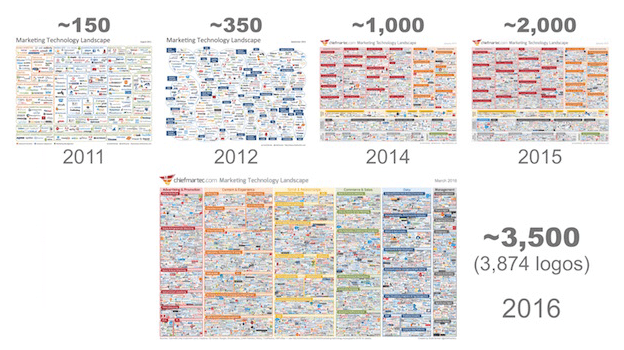The B2B Marketing Technology Stack


What is it? Does it matter? Do I already have one?
Marketing technology is exploding. Scott Brinker’s Marketing Technology Landscape showed 947 companies in 43 categories in 2014 – which seemed overwhelming. Then in 2015 it jumped to 1,876 companies. And we’ve learnt that 2016 has seen it double again, to a massive 3,500 comapnies. So what does this mean for marketers? What does it mean for IT managers? And how can we plan to make the most of the new technologies without getting lost in a sea of data?
The aim of this post is to introduce the core components and purpose of a Marketing Technology Stack. Most of the current literature is aimed clearly at large organisations whose CIO’s, CMO’s and CTO’s are very busy dealing with mega integrations of multi-user software solutions. It’s fascinating to read, but not very applicable to the 60% or so of us who work for slightly smaller companies.
Why should I be thinking about a ‘MarTech Stack’?!
Because you already have one! Without realising it, almost every business no matter how small will have some form of marketing technology stack. And it will naturally grow with your business. If you don’t plan now, you are likely to end up with a tangle of disparate systems all churning out data – none of which you can combine and measure.
Do you have a central database of customer information? Do you send marketing emails? Do you have a website? If yes – you have a three tier marketing technology stack. Add social platforms, analytics, a CMS, Display and Retargeting Ads, and a Marketing Automation platform and suddenly that is a LOT of data. In fact, the average company’s marketing tech stack now consists of 17+ tools (Radius). If you don’t consider how they interconnect at the start, you could end up with a lot of employees working in expensive and unconnected silos. And that is without considering other useful customer data you may have in accounting, events and sales software, amongst others.
OK, I have a stack… and I need to plan my stack…
We’ve established that a solid marketing technology stack will allow you to optimise your spend, time and effort. To achieve this you need a solid foundation to bring together and measure your various tools and components. Getting this base component right at the start, and ensuring it will integrate with your core elements, will allow you to measure each new tool you bring in, as you grow.

Once you have your base component, which will typically be a CRM solution but in some cases may be a Marketing Automation platform, you can choose the tools to integrate into your stack. These may include:
CRM
Linking marketing efforts to the remainder of the business, and especially sales and their pipelines – CRM should be your belt and braces in the technology stack. Integrate marketing and non-marketing technologies and you have your core system ready to go. Most CRM’s will offer enhanced reporting, instant dashboards and enough functionality for Sales, Marketing & Customer Services to work in one system together. It’s also a lot easier for management if all departments use a central system offering board level reports, fast!
Check: Does your provider offer integrations with your key business and marketing software? Better still, can they offer custom integrations? If yes, you know they can grow with you.
Marketing Automation
Marketing Automation is essentially the ability to automate a number of processes. Typically it pulls together a bunch of previously stand-alone marketing solutions such as email marketing, lead management and lead scoring and provides them in one integrated package. Most marketing automation solutions are aimed at the lead generation and qualification stage of new business, and stop at the point you would pass a lead over to your sales team.
There is a very wide range of solutions available on the market available for every speciality. Some contain website CMS, others specialise in content distribution. Each business will need a different solution which may be a big (and expensive) market leader, or may be a combination of smaller tools integrated together.
Check: Can your marketing automation and CRM platforms integrate? If not, you are missing the point of the technology stack, and you are setting up your marketing and sales teams for a lot of misaligned conversations over lead follow up!
CMS
A Content Management System allows you to create, publish, store, edit and collaborate on website content. Typically it is the back end of a company website. There are many options out there, from DIY WordPress websites, through to professional designed sites hosted on the big players such as Drupal, Joomla or Magento. Alternatively you may choose a custom CMS created by a website agency, or a CMS sitting within a Marketing Automation provider. I’ll assume all readers of this blog already have a CMS – as in today’s business world we all need a website!
Check: Carrying out lead generation or customer support through forms? It’s worth ensuring your CMS can integrate with your CRM/marketing automation solution.
An oldie, but a goodie! Email marketing is going to be with us for a while yet so ignore all those blog posts exclaiming “Email is dead!” Automation in marketing is largely email based, used to distribute content and contact leads when they hit a desired score. Make sure you have an email marketing solution that meets your needs.
Check: Before spending on an email solution do check with your CRM and marketing automation providers. Both are very likely to offer email marketing solutions that are already fully integrated! Bonus! No new training or integration spend required.
Analytics & Tracking
Website analytics for B2B now comes in two forms, which I’ve nicknamed Analytics and Tracking. Analytics allows you to analyse (almost) all of your website visitors as a mass of unknown companies. You can identify where website traffic comes from, how it moves through your sites and carry out goal analysis on forms. It’s great to help you work out how well your website is converting visitors to leads and to identify which traffic sources are most valuable to you. Google Analytics is the most popular, and free!
Tracking is a newer technology. Like analytics it uses IP addresses to track, but unlike analytics it only shows you information on the IP addresses it can identify. Using tracking software allows you to work out which company the website visitor is from (expect to be able to identify 10-30% of all traffic), and target them accordingly. This may be a direct sales approach, but more often (and more successfully) it is a great way to score existing leads and measure their interest.
Check: It’s nice to integrate website analytics into your stack, but it isn’t essential. As website analytics is a mass of unknown website visitors you cannot tie it up with lead and customer data, so it isn’t the end of the world to work on this data outside of your technology stack. On the other hand, IP Tracking is only valuable when it is fully integrated with your lead and customer data.
Ad Technology
If you have ticked of the above as a fully integrated solution – congratulations you’ve got a solid tech stack! Ad Technology isn’t quite a clear. In a large enterprise you would want to manage this within your stack for control purposes, however in smaller organisations you will often have just one person managing your online PPC ads, display ads and retargeting. In this situation it is fine to manage these in their own platforms – as long as you are pulling the data in! If your central base can identify where your traffic is coming from, you are able to measure, compare traffic sources and plan accordingly.
Social
This will have differing levels of importance to different businesses. If you manage customer service via Twitter – you will need high-level integration, especially with your CRM alerting functionality. If you have a presence and carry out the odd post, it isn’t as important. However, almost all marketing technology will integrate with the main social platforms. At the minimum ensure you can search hashtags and mentions of your brand, and you can measure incoming website traffic from social.
SEO & Content
I’ve bundled together two gigantic topics here, as this blog isn’t going to go into the depths of SEO or content marketing. Both sit nicely in the ‘inbound’ marketing sphere, and both become more and more relevant the further your tech stack has evolved. Content makes up the lifeline of automated lead nurture email series, and the kind of content and frequency of it will largely depend on your industry and team size. SEO is essential for us all, and there are many blogs across the internet to get you started. It’s worth ensuring you have the basic tools in your CMS to manage these, and as your abilities grow you may find you want to integrate technology into your stack to manage both SEO and content.

 Thanks to Penni Stanton for sharing her advice and opinions in this post. Penni is the Marketing Manager at Gold-Vision CRM. You can follow Gold-Vision on Twitter or LinkedIn, and you can find Penni on Twitter too.
Thanks to Penni Stanton for sharing her advice and opinions in this post. Penni is the Marketing Manager at Gold-Vision CRM. You can follow Gold-Vision on Twitter or LinkedIn, and you can find Penni on Twitter too.
From our sponsors: The B2B Marketing Technology Stack



